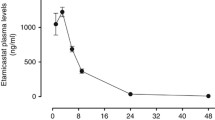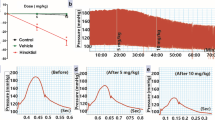Summary
The effect of guanfacine and hydrallazine on cardiovascular haemodynamics and on sympathetic nervous activity has been studied in 16 patients with essential hypertension. Two groups of patients were investigated: in Group A guanfacine brought the blood pressure back to normal (diastolic blood pressure ⩽90 mmHg), and in Group B diastolic blood pressure was > 90 mmHg and required the addition of hydrallazine. Guanfacine significantly decreased heart rate, plasma renin activity and urinary excretion of noradrenaline, without altering cardiac contractility. In Group B, guanfacine 2 to 6 mg/day produced a significant decrease in blood pressure from 178.7/112.4 to 164.4/102.9 mmHg and in heart rate from 77.1 to 62.7 beats/min after 4 weeks of treatment. Guanfacine did not significantly alter preejection period, cardiac output or total peripheral resistance. Hydrallazine 50 to 300 mg/day caused a further reduction in blood pressure from 164.4/102.9 to 150.7/90.2 mmHg and an increase in heart rate from 62.7 to 72.1 beats/min. Limb blood flow was increased from 4.55 to 5.93 ml/100 g/min and limb vascular resistance was decreased from 39.55 to 23.6 mmHg 100 g·min/ml. Hydrallazine also caused a slight increase in plasma renin activity and urinary excretion of noradrenaline. It is concluded that guanfacine is a useful agent to block a hydrallazine-induced increase in sympathetic nervous activity.
Similar content being viewed by others
References
Velasco M, Gilbert CA, Rutledge CO, McNay JL (1975) Anti-hypertensive effects of a dopamine beta hydroxylase inhibitor, bupicomide: a comparison with hydralazine. Clin Pharmacol Ther 18: 145–153
Pettinger WA, Mitchell HC (1973) Minoxidil — an alternative to Nephrectomy for refractory hypertension. New Engl J Med 289: 167–171
O'Malley K, Velasco M, Wells J, McNay JL (1975) Control plasma renin activity and changes in sympathetic tone as determinants of minoxidil induced increase in plasma renin activity. J Clin Invest 55: 230–235
Guevara J, Velasco M, Hernandez-Pieretti O (1977) Treatment of severe essential hypertension with combined hydralazine and propranolol. Curr Ther Res 21: 288–291
O'Malley K, Velasco M, Wells J, McNay JL (1976) Mechanism of the interaction of propranolol and a potent vasodilator anti-hypertensive agent-minoxidil. Eur J Clin Pharmacol 9: 355–360
Velasco M, Guevara J, Urbina-Quintana A, Hernandez-Pieretti O (1977) Combined clonidine and hydrallazine therapy in severe and refractory hypertension. Acta Cient Venez 28: 342–345
Velasco M, Bertoncini H, Romero E, Urbina-Quintana A, Guevara J, Hernandez-Pieretti O (1978) Effect of clonidine on sympathetic nervous activity in hydrallazine-treated hypertensive patients. Eur J Clin Pharmacol 13: 317–320
Velasco M, Andrews-Figueroa P, Ramirez A, Morillo J, Urbina-Quintana A, Hernandez-Pieretti O (1981) Systemic and cardiac hemodynamic interactions between clonidine and minoxidil. Clin Pharmacol Ther 30: 158–163
Weissler AM, Garrard CL (1971) Systolic time intervals in cardiac disease. Mod Concepts Cardiovasc. Disease 40: 1–8
Haber E, Koerner T, Page LB, Kliman B, Purnode A (1969) Application of radioimmunoassay for angiotensin I to the physiological measurements of plasma renin activity in normal human subjects. J Clin Endocrinol Metab 29: 1349–1355
Anton AH, Sayre DF (1962) A study of the factors affecting the aluminum oxide trihydroxy-indole procedure for the analysis of catecholamines. J Pharmacol Exp Ther 138: 360–375
Greenfield ADM, Whitney RJ, Mowgray JF (1963) Methods for the investigation of peripheral blood flow. Br Med Bull 19: 101–109
Snedecor GW, Cochran WG (1971) Statistical methods (6 edn), Iowa University Press, Iowa
Dollery CT, Davies DS (1980) Centrally acting drugs in anti-hypertensive therapy. Br J Clin Pharmacol 10: 55–125
Schoeppe W, Brecht HM (1980) Guanfacine in essential hypertension effect on blood pressure, plasma noradrenaline concentration and plasma renin activity. Br J Clin Pharmacol 10: 975–101S
Ablad B (1959) Site of action of hydrallazine and dihydrallazine in man. Acta Pharmacol Toxicol 16: 113–128
Velasco M, Urbina-Quintana A, Hernández E, Ramírez A, Aliendres R, Morillo J, Hernández Pieretti O (1981) Effect of minoxidil on sympathetic nervous activity in clonidine-treated hypertensive patients. Eur J Clin Pharmacol 20: 259–262
Author information
Authors and Affiliations
Rights and permissions
About this article
Cite this article
Velasco, M., Urbina-Quintana, A., Morillo, J. et al. Systemic and cardiac haemodynamic interactions between guanfacine and hydrallazine in hypertensive patients. Eur J Clin Pharmacol 27, 393–396 (1984). https://doi.org/10.1007/BF00549584
Received:
Accepted:
Issue Date:
DOI: https://doi.org/10.1007/BF00549584




